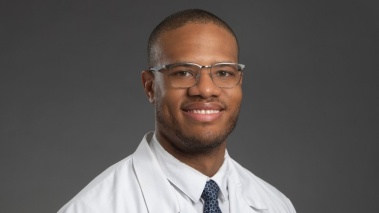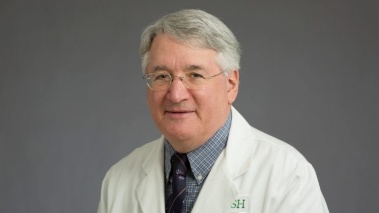Like many of us, Sandra Gomez-Perez, PhD, RD, LDN, is concerned about body fat, especially fat around the abdominal area. For Gomez-Perez, though, the issue isn’t about personal appearance. It’s an important component of disease prevention.
A researcher at Rush University Medical Center, Gomez-Perez explores the complexities of adipose tissue, commonly known as body fat. She keeps an extra close eye on visceral adipose tissue, or VAT, a type of fat stored around the intra-abdominal organs — including the gastrointestinal tract, liver and pancreas — and the role it can play in disease.
“We've come a long way in our understanding of adipose tissue,” says Gomez-Perez, an assistant professor in the Department of Clinical Nutrition in the College of Health Sciences at Rush University. “We certainly know that disease appears to be related to where your fat is stored, and how much is stored.”
Measuring fat with CT scans
She uses CT scans to investigate the relationship between types and distribution of fat. Through this work, Gomez-Perez hopes to increase our understanding of diet and nutritional links to cancer, especially colorectal cancer, which is the second-deadliest form of cancer in the United States.
One of the fruits of Gomez-Perez's work has been to demonstrate that CT scans, a common technology used in health care, can be a great tool for evaluating body composition.
CT imaging can take a precise measure of the abdomen and identify types and amounts of fat there. It can measure skeletal muscle, which makes it possible to assess a person's nutritional needs and determine appropriate drug dosages, particularly for patients receiving chemotherapy, as some research has shown, though this is not currently applied in clinical use.
CT scans also can detect the presence of sarcopenia, or low skeletal muscle mass, which is an aging-related condition associated with chronic states of illness, inflammation and malnutrition.
“My passion is trying to find out what is happening before it happens, and how to prevent it,” she says. “Prevention is the key” in diet-related diseases such as obesity, diabetes and perhaps even cancer.
Investigating the dangers of VAT
Despite its bad reputation, fat plays an important role in the body. It stores energy, insulates and protects our organs, and performs a number of other tasks crucial to our metabolism. “Adipose tissue is intimately involved in normal physiological function — digestion, growth, immune response, reproduction, generating body heat,” says Gomez-Perez, who has been at Rush since 2016.
Too much fat, however, can be a problem, especially VAT, which accumulates around the midsection. It’s why your physician might ask about your waist circumference, which is an indicator of VAT. To avoid serious health risks, a woman's waist should measure no more than 35 inches while a man’s should be less than 40 inches.
You also have subcutaneous adipose tissue just under the skin and fat between the muscles. Generally, though, it’s excess VAT that appears to be an important determinant of disease risk. Excessive amounts increase the risk of conditions such as diabetes, heart disease, colorectal cancer and other cancers.
A body fat threshold
What happens to VAT that makes it so dangerous? That's what Gomez-Perez wants to know.
“We think there's a threshold that certain adipose tissues can handle,” she says.
When that level is exceeded, as in some cases of obesity, adipose tissue loses elasticity and may become metabolically unstable. “These tissues don't work in isolation,” Gomez-Perez explains. “It's a complex thing to study, but we have plenty of evidence that excess VAT is a big culprit in contributing to the development of major chronic diseases.”
One of Gomez-Perez’s recent studies was a retrospective look — that is, the data had already been collected — at factors that might have led to colorectal cancer. “Current research suggests African-American individuals have higher rates of colorectal cancer than non-Hispanic whites, and I wanted to see if the amount of VAT is a factor in increasing colorectal cancer risk for African-Americans.” Unfortunately, her research did not establish this link, but that may be due to the fact that “cancer can take a long time to develop and considerable changes in body composition could have occurred, including changes to VAT, before the cancer was diagnosed,” she says.
‘Great opportunity’
Gomez-Perez is excited about “the great opportunity” she'll have this year to join an ongoing five-year, NIH-funded study as a co-investigator. The study is following black and non-Hispanic whites who do not have cancer through screening colonoscopies to explore whether certain bacteria that flourish in the intestines of people with a diet rich in meat protein may increase the risk for colorectal cancer in either one or both groups. She’ll be collaborating with a Rush colleague, Ece Mutlu, MD, director of clinical research in the Rush Section of Gastroenterology, who is co-principal investigator of the study, along with Lisa Tussing-Humphreys, PhD, at the University of Illinois at Chicago and Rex Gaskins, PhD, at the University of Illinois at Urbana-Champaign.
In addition, Gomez-Perez will be investigating if the location of fat in the body is associated with the development of colorectal adenomas, which are abnormal growths in the colon with the potential of progressing to colorectal cancer. She hopes to “capture the role of adipose tissue” in the early stages of the process that leads to the potential development of colorectal cancer. It is a continuation of work she started in adults with a diagnosis of colorectal cancer, she says.
‘A scientist at heart’
Gomez-Perez, who was born in Puerto Rico and raised in Chicago, began her career as a clinical dietician; however, she says, "I think I've always been a scientist at heart. I want to ask the difficult questions."
Nutrition is a great field for research, she has found. "What we eat is so important to our health."
Obesity in particular is a condition that concerned her deeply as a clinician, and she's eager to investigate it as a researcher. "How do we prevent obesity so that we prevent the cascade of events that follow?" she says.
Before joining Rush, Gomez-Perez was a project coordinator in nutrition and translational research in minority and underserved populations at the University of Illinois at Chicago, or UIC, for 16 years. She was a predoctoral fellow with the National Institutes of Health-funded Cancer Education and Career Development Program at the Institute for Health Research and Policy at UIC, where she obtained her PhD in kinesiology, nutrition and rehabilitation sciences with a concentration in nutritional epidemiology, race/ethnic disparities and cancer.
Gomez-Perez is active with the national group Latinos and Hispanics in Dietetics and Nutrition, a member interest group of the Academy of Nutrition and Dietetics, which focuses on improving the health and nutrition of Latinos and provides mentoring opportunities to Latino students interested in dietetics and nutrition.
"That's my other passion," she says. “You have to pay it forward.”







